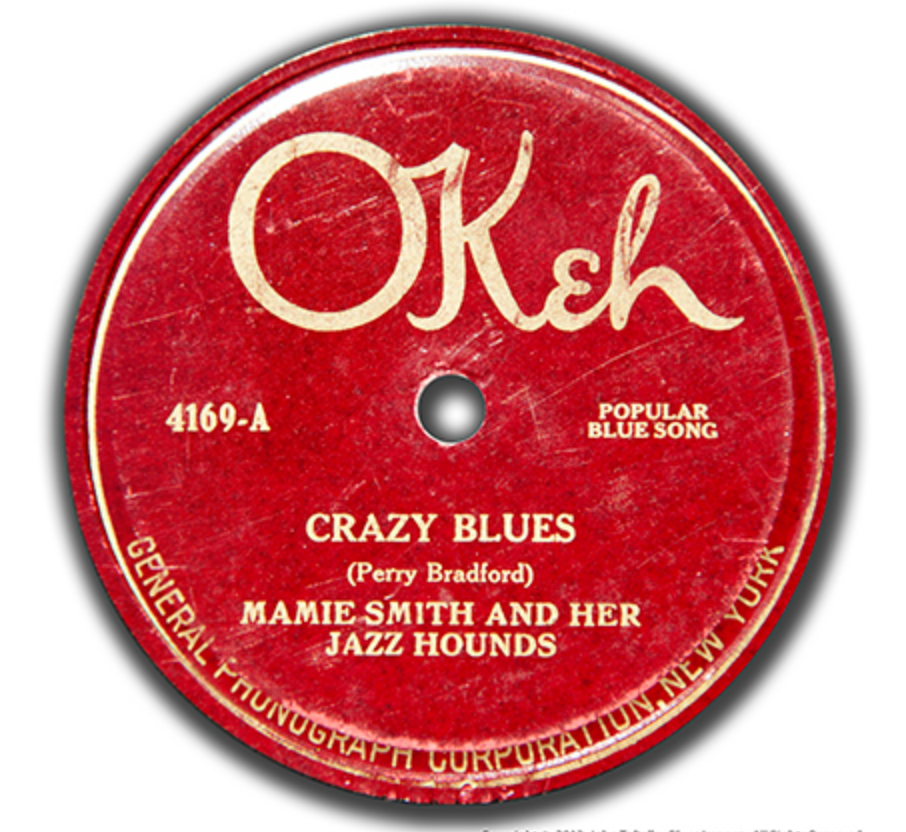Mamie smith records “Crazy blues” at Okeh Studios
ALSO SEE OUR FEBRUARY 11 AND 14 POSTS ABOUT MAMIE SMITH, PERRY BRADFORD, AND OKEH RECORDS
One hundred years ago today … Mamie Smith sang “Crazy Blues” and “It's Right Here for You,” at Okeh Studios, 25 West 45th Street; the songs would appear that November as two sides of a 78 rpm record (the industry standard). The release is usually referred to as the first blues record. That designation is debatable, but Roger Smith nails it when he calls it “the first significant hit recording in the blues genre.” The success of “Crazy Blues” spurred a vogue for “race records” that revolutionized US popular music.
Listen to “Crazy Blues,” courtesy of Youtube.
Courtesy John Tefteller’s Blues images.
We posted about Smith, who by 1920 was a 25-year veteran of black vaudeville stages and cabarets, for the centenary of her appearance at Okeh on February 11 and 14, along with composer/arranger/producer/general impresario Perry Bradford. Smith, on (one or both of) those dates in 1920, recorded “That Thing Called Love,” and “You Can't Keep a Good Man Down” (two Bradford compositions) in the standard vaudeville style, backed by the Okeh house orchestra. The record surprised everyone, except possibly Bradford, in selling 75,000 copies. Okeh wanted more (Martin, 36).
For the August 10 date Smith and Bradford pushed the envelope, choosing two Bradford compositions with strong blues elements, notwithstanding the fact that both had been written for stage productions. “Crazy Blues,” was actually a renamed Bradford song “Harlem Blues,” itself an adaptation of a blues standard that had gone by many titles (according to Ed Komara). Smith had sung “Harlem Blues” in Bradford's Made in Harlem (sometimes Maid in Harlem) in 1918–19, inspiring the producer to get her recorded.
To play the blues arrangements, a band of handpicked Harlem musicians was brought in and christened the Jazz Hounds.
Sheet Music cover for “Crazy Blues,” showing the Jazz Hounds.
Integral to this group was pianist Willie “the Lion” Smith, who was then making a name for himself as a leader in the faddish jazz genre. Willie Smith, indeed, may have been the one to put together the Jazz Hounds. In his 1964 autobiography, he claims that it was he, not Bradford, who recruited the band and ran the session. In his 1965 autobiography, Bradford refutes all that.
Cover of Music on My Mind: The Memories of an American Pianist. Courtesy Abebooks.com
Cover of Born with the Blues: The Salty and Uninhibited Autobiography of one of the Greatest of the Old-Time Jazz Pioneers. Abebooks.com
Roger Smith writes of Bradford’s musical inventiveness in “Crazy Blues”:
A 21st-century listener not steeped in the historical progression of syncopated music may have trouble discerning what made “Crazy Blues” a unique record in its time. Part of its innovation can be found in the composition’s musical structure. Bradford sandwiches 12-bar blues stanzas between a traditional 16-bar verse and 16-bar chorus.
The lyrics, meanwhile, surely raised 1920 eyebrows, with their references to heroin and killing a police officer.
I'm gonna do like a Chinaman,
Go and get some hop,
Get myself a gun
And shoot myself a cop!
I ain't had nothing but bad news
Upon its November release, the record was an immediate success, according to Lerone A. Martin:
The record, accompanied by a large window display featuring Mamie Smith, was sent to record dealers just in time for the Thanksgiving holiday. It purportedly went on to sell one million copies. (37)
By June of the following year, the US market was flooded with "race records"—songs in the blues or jazz idioms by African American performers.
SOURCES / FURTHER READING:
Martin, Lerone A. Preaching on Wax: The Phonograph and the Shaping of Modern African American Religion. New York: NYU Press, 2014.
WRITTEN BY JONATHAN GOLDMAN, AUGUST 10, 2020.
TAGS: music, recording, jazz, blues, African American history, black history, women musicians




